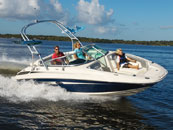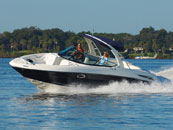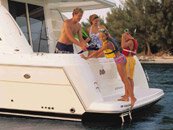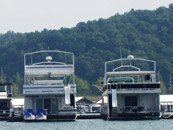Make your next blue-water adventure safe and enjoyable with these trip-planning and boat-handling tips.
By Capt. Stuart Reininger
I recently found myself at an impromptu dinner in a restaurant in Beaufort, North Carolina, with eight other skippers who were bringing their powerboats from various East Coast ports to points south. For half of them, it was their first real offshore trip, and they loved every minute of it. That evening, we all agreed there are few things in life more satisfying than the end of a long journey at sea.
Going the distance offshore is a dream many boat owners share, but even the most optimistic cruisers know problems can and often do occur on these big trips. Fortunately, you can prevent the most common setbacks with careful planning and a few good boat-handling tips. In a busy year, my crews and I move six to eight boats over distances of 500 miles or more. Much of the travel occurs during the spring and fall delivery seasons, when weâll range from the Maine coast to the Florida Keys. Iâve learned some valuable lessons over the years and along those miles, and a number of them could benefit you.
The Systems Check
On one trip up the East Coast, a skipper drew quite a bit of attention when he turned the radio airways blue with repeated calls to Sea Tow. He had one breakdown or fuel crisis after another during a run from Virginia to Maine, and he managed to complete a few legs of his trip at the end of a hawser. Fortunately, this scenario isnât typical and the towboat services have procedures to identify and prevent people who think of them as private limos. But we can learn one thing from this boater: He did his homework. When he planned his cruise, he identified the territories covered by tow service, and thatâs something every skipper should do to prepare for an unforeseen problem. Unfortunately, this person took blatant advantage of his membership, since his mechanical problems were the result of carelessness and poor maintenance. When most cruisers make a call for help, itâs usually despite meticulous preparation.
This skipperâs experience also raises the important subject of maintenance. Most of us know to give the shipâs systems a good going over before leaving the dock for an offshore hop. We change the oil and filters, check tension on belts, work the seacocks and finger the hoses. But few of us shut down and perform checks when under way. Did you know itâs a rule on most military and commercial vessels to do a check at every watch change? If youâve been running for more than two hours and have at least two more to go, itâs good seamanship â conditions permitting â to shut down and visit the engine room.
Planning Your Route
When preparing for a cruise that could entail long offshore jumps, you need to take a close look at the route you intend to follow, as well as the possible alternatives. When Iâm planning a delivery, I will waypoint â with the on-board chart plotter and a portable unit â every possible destination along the route and every reasonable alternative in the event I have to change plans. I back this up on a paper chart. (During the trip, I also keep a log, which includes engine and fuel information along with latitude/longitude continuums updated with every watch change.)
Weather plays a big part in route planning. The local NOAA broadcast is the first resource most of us consult; itâs updated regularly and accuracy is high in the 24- to 48-hour forecast periods. But I also want a good longrange forecast and weather discussion, even though I know the further out the projection, the more likely unforeseen changes can occur. For this I use the NOAA zoned website (nws.noaa.gov/om/marine/zone/usamz.htm), which includes real-time offshore buoy reports and links to related weather sites.
Naturally, when you plan a route, you take into consideration the size of the boat, its ability to stand up to inclement weather and its fuel capacity. Based on those parameters, I use the following guidelines to determine how far offshore to run.
When cruising north or south along the East Coast with westerly winds present, seas should be calmer inshore due to the lee affected by the land. I corroborate this with buoy reports. The opposite, of course, would apply when cruising the West Coast, where boaters are more likely to find nearshore lees when winds have an easterly component.
An onshore breeze will often kick up an uncomfortable chop near shore. This could be due to the depth change from deep offshore seas to relatively shallow inshore waters. Meanwhile, that same breeze can give rise to well-spaced ocean swells farther out that are not unpleasant for the crew or the boat.
When running with a following sea or wind, I try to be more aware of my surroundings since deteriorating weather is not as noticeable as it is when headed upwind/ up-sea. The up-sea vessel, for instance, will begin pounding as seas increase, thus giving the skipper ample warning to slow down, adjust course or take another action. The crew of the down-sea boat, though, might not recognize what could be dangerous seas until the boat reacts (fishtailing, for instance), at which point the skipperâs options can be greatly diminished. In a following sea, I look for changes in the size and pattern of surrounding waves that might indicate worsening weather. If the pattern and frequency of whitecapped seas change, thatâs a dead giveaway for you to hike your awareness level.
If youâre planning a long run north or south along the East Coast, be aware of the location and strength of the Gulf Stream â that northward-running river in the Atlantic Ocean can save you fuel and time. South-bounders, of course, want to avoid the Gulf Stream. I consult a website (ocean-pro.com/htmfiles/gulfstream2.htm) to help me determine the location of the Stream in relation to my proposed route.
When the Stream is a consideration, I keep a few key things in mind. First, if there is a northerly component to the breeze, I stay out of the Stream until the wind shifts, no matter what direction Iâm headed, especially if Iâm in a narrow or constricted waterway (think Straits of Florida) or in an area of rapidly changing depths (Cape Hatteras, North Carolina). Northerlies in the Stream can build big seas, and in places like the Straits of Florida, those seas can be proven ship-killers. If youâre heading east from any point off the southern coast of the United States toward any point in the Bahamas, it should be easy to avoid a northerly if you have an accurate and up-to-date forecast.
West Coast boaters may encounter the southernflowing California Current. Not as intense or as compact as the Gulf Stream, the more diffuse California Current will have less of an effect on a vesselâs progress, but due to its considerably colder water, itâs responsible for much of the West Coastâs nearshore and offshore fog. For tips on running in fog, see the Boat Handling column, "Out of Sight," in this issue.
Running Inlets
When I plan routes for an offshore run, I take a close look at every inlet I intend to enter or might have to approach if my plans change. Iâm familiar with many inlets, but I never become complacent. I recently made a latenight â and off-season â approach to the inlet at Ocean City, Maryland. Instead of picking up the beacons I expected to find, I was looking at what appeared to be an electrified Christmas tree farm. A major dredging and seawall reconstruction project was under way. Yes, I got it all sorted out and picked my way in without incident, but who needs surprises? Research an inlet long before you approach it. Cruising guides and the Coast Pilot are important resources, as is the navigation section of the website for the Army Corps of Engineers (www.vtn.iwr.usace.army.mil/navigation/navrecentprojects.htm).
Under normal conditions, entering an inlet is often a nobrainer, but even so, you should remind yourself of something before throttling forward â namely, that you probably wonât be alone inside. When at sea, the odds are rare for threatening ship-to-ship interactions, but when youâre between jetties or flanked by shallows, the actions of others can seriously impact the well-being of you and your crew, no matter how skillful a boat handler you may be. Here are some ways to reduce the possibility of a mishap.
Never make a direct approach into an inlet, especially one that might necessitate a sharp turn between the jetties. I always go out to the sea buoy so I can scope out the situation. I also announce my presence to nearby boats with a security call on Channels 16 and 9. In addition, I prefer not to have anyone below when entering an inlet, so I ask all crew to come up on deck.
Under normal circumstances, you donât have to be too concerned about the tidal or current situation in an inlet unless it affects your approach to a bridge or berth. However, when approaching in inclement weather, the current can make a big difference. When a stiff onshore breeze meets a fast ebb, a chop can build up outside the inlet. At best, it will make entry uncomfortable; it could also create downright dangerous conditions. On the other hand, when the tide changes, the effect can be equally dramatic as the seas lie down and pave the way for a comfortable approach. Thatâs another reason for making the approach from the sea buoy, since itâs a good place to hang out and wait for the tidal change. Of course, you should have up-to-date tidal information at hand.
Problems can and do occur on long coastal cruises, but you can prevent serious trouble with good planning and common sense. In the long run, one of the rewards for those efforts could be a memorable dinner with a group of very satisfied skippers.
Shared with permission by MotorBoating.



